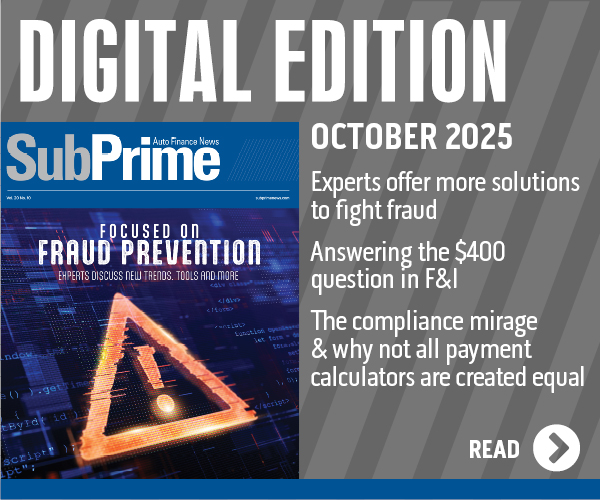March auto defaults stay on steady pattern

By subscribing, you agree to receive communications from Auto Remarketing and our partners in accordance with our Privacy Policy. We may share your information with select partners and sponsors who may contact you about their products and services. You may unsubscribe at any time.
NEW YORK –
Perhaps stable is the best adjective to describe the auto loan default readings included in the latest S&P/Experian Consumer Credit Default Indices.
The March reading released this week by S&P Dow Jones Indices and Experian came in at 1.02 percent, which is 1 basis point lower than the same month last year and 3 basis points lower than what analysts noted for February.
The auto loan component for this monthly default analysis has stayed at or no more than 5 basis points above the 1.00 percent mark for 14 of the past 20 months going back to August 2014.
And the other six months contained within that span, the auto default reading was below that 1.00 percent threshold.
S&P and Experian also reported this week that the March composite rate — a comprehensive measure of changes in consumer credit defaults — settled at 0.93 percent, down 4 basis points from the previous month.
The firm noticed a first mortgage default rate at 0.77 percent for March, down 7 basis points from the prior month.
Subscribe to Auto Remarketing to stay informed and stay ahead.
By subscribing, you agree to receive communications from Auto Remarketing and our partners in accordance with our Privacy Policy. We may share your information with select partners and sponsors who may contact you about their products and services. You may unsubscribe at any time.
The bank card default rate increased 36 basis points in March, recording a default rate of 2.92 percent.
Four of the five major cities that analysts watch for the monthly update saw their default rates increase during the month of March.
Miami reported a default rate of 1.15 percent, up 8 basis points from February.
Los Angeles posted a default rate of 0.81 percent in March, up 5 basis points from the prior month.
New York had a default rate of 0.99 percent, a 2-basis-point increase from the previous month.
Chicago generated a default-rate increase of 1 basis point, posting a 1.03 percent default rate for March.
Dallas was the only city to report a default rate decrease with a 0.75 percent default rate, representing a 28-basis-point drop from February.
“The continuing low rates of consumer credit defaults in mortgages, auto, and bank card loans are positive signs for the economy,” said David Blitzer, managing director and chairman of the index committee at S&P Dow Jones Indices.
“Large mortgage debts followed by rapidly rising defaults in all kinds of consumer credit were key causes of the financial crisis,” Blitzer continued. “Conditions today are much improved; not only are defaults down, but outstanding mortgage balances were about 12 percent below the peak seen in the first quarter of 2008.
“Debt service ratios are close to the record lows set in the last two years as well. This all suggests that consumer spending should continue to support modest economic growth,” he went on to say.
With the auto finance sector showing stability, Blitzer elaborated more about the segment that posted more movements. He pointed out the rate of bank card defaults is both greater and more volatile than mortgage defaults.
Blitzer explained that behind the figures are further differences in these borrowing patterns. He mentioned outstanding balances for bank cards, as measured by the Federal Reserve's figures on revolving credit, were up 5.2 percent in 2015 compared to an increase of 1.0 percent for mortgages on one-to-four family residences.
“Bank card balances, which surged in the first half of 2014, leveled off somewhat until the start of 2015, and then accelerated again through the end of last year,” Blitzer said. “They are down slightly for the first two months of 2016.
“Mortgage balances are quite different,” he continued. “Until the last quarter of 2014, outstanding mortgage balances declined and then saw a small increase in 2015. These tell different stories about consumer behavior.
“While bank card balances and defaults saw increases, consumer prices were flat, indicating that the growth in balances reflects increased spending,” Blitzer went on to say. “Mortgage balances barely grew even though home prices, as measured by the S&P/Case-Shiller Home Price Index, are rising 5 percent to 6 percent annually.
“The substantial majority of home sales are of existing homes, which means mortgages are being paid off at the same time new mortgages are being written,” he added.


